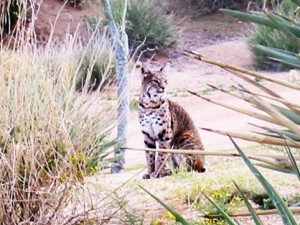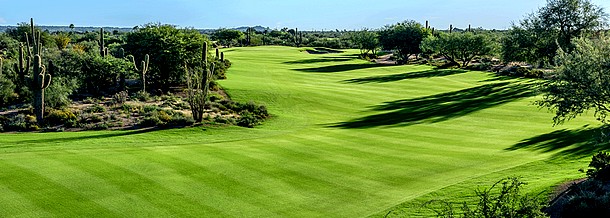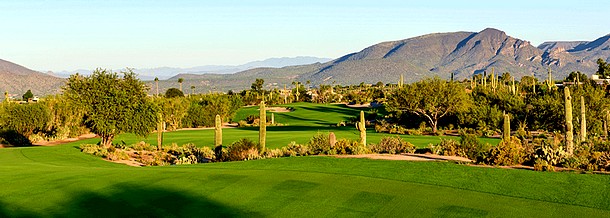Desert Forest Golf Club: Phil Mickelson, who starred at Arizona State University and made his home for several years in nearby Scottsdale, called this his “favorite” golf course in Arizona, which is about as good an endorsement as any course in the state could receive. When you add that salute to the fact that several of its members maintain memberships at Augusta National, Baltusrol, Crooked Stick, Medinah, Pine Valley and Shinnecock, well that pretty much sums up the stature of Desert Forest.
Yes, the name is a a bit of a contradiction in terms, but like its location in the ultra-chic town of Carefree, those in the know understand what it represents.
In a word, “pure” probably works the best for Desert Forest Golf Club. No swimming pool, no fitness center, no tennis club, just golf. And golf the way the legendary designers envisioned the game being played. In this case, the designer is Robert “Red” Lawrence, who created an absolute gem that earned him the nickname “The Desert Fox” of design, long before Johnny Miller picked up that moniker as a player.
Lawrence worked on fabled Merion Golf Club in the 1920’s along with historic Westchester Country Club and the minimalist design he opened here in 1962 propelled Desert Forest Golf Club into the ranks of the world’s elite private golf clubs, where it remains to this day.
In the early 1960”s, when Lawrence first laid eyes upon the unblemished desert terrain of the Sonoran Foothills in Carefree, Arizona, he decided to build a revolutionary layout, the first of its now familiar kind: a golf course simply laid upon the striking native-desert topography, hewn by eons of wind, rain and erosion.
Golfweek magazine’s take? “A revolutionary landmark of golf architecture.”
Modern day accolytes, think Sand Hills Golf Club in Nebraska, followed Lawrence’s gospel and relied on the natural landscape, moving virtually no soil during construction. Tom Weiskopf and Jack Snyder have done a little “tweaking,” and David Zinkand from the Coore & Crenshaw school has managed a modernization, but what Lawrence created remains intact.

As you would expect, “pure golf” on this true desert course means Desert Forest has no water hazards in play, unless you are pathetic enough to dribble one sideways into the pond to the left of the tee on the par-3 third hole.
What might surprise you is you’ll find no O.B. stakes, and not a single fairway bunker on the course; zip, zero, nada, none. You’ll learn quite quickly that Lawrence utilized the natural contours to defend the fairways so well, fairway bunkers are unnecessary here.
Instead, Desert Forest presents the pure natural canvas that is its hallmark, and allows its native desert topography to dictate playing angles and shot placement. It’s just you and your clubs against the big three: the course, the elements and your patience.
Zinkand’s recent $3 million modernization recaptured the original profiles and contours of the green complexes and Lawrence’s signature oval-shaped bunkers were updated to a natural rugged-edge profile. More than a million square feet of rough and fairway surfaces were converted to 328 Bermuda turf as well.
Desert Forest offers multiple sets of tees, ranging from 4,763 to 7,201 yards, and the par-72 layout is rated at 74.1 with a slope of 145 from the tips. There are several classic holes, but the par-5’s are particularly outstanding at 551, 553, 594 and 523 yards. As for a signature hole, we’ll take the par-5 seventh, which plays at 551 from the back tee, is the No. 1 handicap and as strategically conceived as any hole in Arizona.
It offers two distinct paths to the green. Left off the tee is easier and safer, but makes it a 3-shotter with a third measuring about 150 yards to the green. The bolder path, and the one Mickelson definitely would take, is down the right side, leaving an approach of 225-250 yards to the green. Key elements of this risk-reward choice are a waste-like scrub area running on a diagonal axis which divides the fairway from the tee, and the right-side’s more dramatic second shot which must carry an arroyo about 20 yards wide crossing the path to the green.
Desert Forest’s 250 members prefer and enjoy the simple elegance of the understatement, as evidenced by the first three entries on the club’s Master Plan Principles:
The golf course is our first priority.
Hire all the necessary experts and follow their advice.
Provide adequate funding to do it right.
Amen!
Perhaps that’s why Desert Forest, the first desert golf course, is still the best desert golf course. For non-members who appreciate brilliant course design and are fortunate enough to receive the opportunity, tee it up and savor the experience. Everyone else can enjoy a hole-by-hole helicopter fly-over of the course at www.desertforestgolfclub.com.
Enjoy our review of every golf course in Arizona at Arizona Golf Course Reviews. It’s just a part of “All Things, Arizona Golf” at the Arizona Golf Authority.

